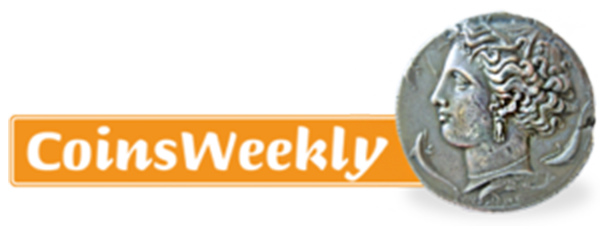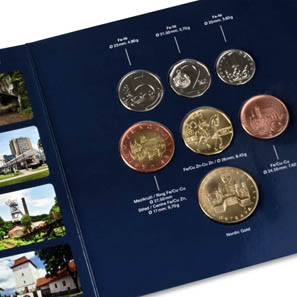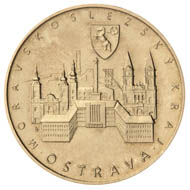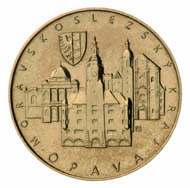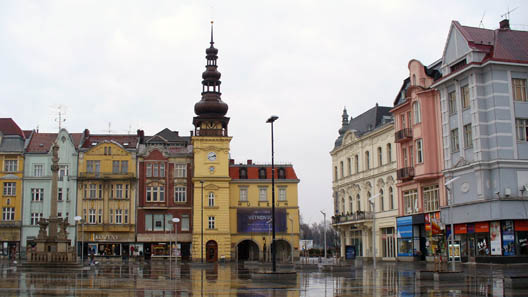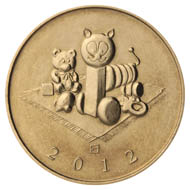March 22, 2012 – The Czech Mint issues a folder focusing on the historical region of Moravia-Silesia. The six circulation coins are accompanied by an exclusively designed medal of nordic gold.
The 2012 circulation coin set comprises the current circulation coins with the face values of 1, 2, 5, 10, 20 and 50 Czech crowns (Czech koruna). The coins of 1, 2 and 5 Czech crowns are made of steel electroplated with nickel. The 10-koruna-coin is struck of steel electroplated with copper, the 20-koruna-coin has a core of steel with an alloy of copper and zinc being electroplated with a copper-zinc-alloy. The coin with the highest face value, 50 Czech korunas, is bimetallic: in the centre steel is clad with a copper-zinc-alloy, on the ring only with copper.
The circulation coin set.
Being legal tender all those coins show the rampant Czech lion on their obverse. The reverse gives the numeral and additional attributes: St Wenceslas crown (1CZK), Great-Moravian button-jewel (2 CZK), Charles Bridge over the river Vltava (5 CZK), Petrov national monument in Brno (10 CZK), statue of St Wenceslas in Prague (20 CZK), and a panoramic view over Prague (50 CZK).
The exclusively designed medal.
The medal as well deals with the folder’s topic – the significant historical regions of Moravia and Silesia. The artist Petra Kobrlová dedicated each side to one of the two eminent towns of these regions.
Ostrava’s marketplace. Photo: Pudelek / Wikipedia.
The obverse shows the landmarks of Ostrava and its district: the townhall, the Church of Immaculata, the Old Townhall housing the museum, as well as the mining tower and the Cathedral. The municipal coat of arms in the upper right of the field completes this visual ensemble of the third largest city of the Czech Republic.
Church of St Adalbert in Opava. Photo Pudelek / Wikipedia.
The reverse shows famous monuments of the neighboring city of Opava: townhall, museum of Silesia, the Assumption Church, and the Church of St Adalbert. Here as well the resplendent coat of arms of the city in the upper field helps in identifying the location. The set is limited to 10,000 pieces. The lavishly illustrated folder gives many information on the topic.
Moravia and Silesia are the two eastern parts of the Czech Republic bordering on Poland in the North. An important trade route crossed this region since antiquity and the middle ages serving to transport among others amber from the Baltic to the Adriatic Sea. In the ninth century the whole area was united by the state of Great Moravia, which later became part of the Lands of the Bohemian Crown and thus consequently part of the Habsburg Monarchy until 1918.
Until 1945 a significant part of the Moravian and Silesian population was of German origin. Many of the settlers had reached there in the course of the German eastward expansion in the 12th and 13th centuries. Despite of the large expulsion of Sudeten Germans after 1945 even today architectural monuments remember their impact on this area.
By the way, many distinguished personalities of the European cultural history come from the Silesian-Moravian region around Ostrava and Opava, like romantic poet Joseph von Eichendorf, Gregor Mendel, “father of modern genetics”, and Sigmund Freud, founder of psychoanalysis.
Today the region lives primarily on the industry that has influenced nature and cities there. But besides that one can experience a breathtaking nature that invites to climbing and hiking. This circulation coin set gives an astonishing impression of what historical monuments in that region are still to discover.
The baby folder’s medal.
In addition the Czech Mint has issued a circulation coin baby and christening set. A fitting gift for parents of a new born baby in 2012: Inside you can compile the folder with all data of the new arrival. This folder is limited to 10,000 pieces, too.
All information on these and other coins and medals of that mint you will find on the website of the Czech Mint.


